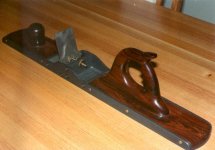Vancbiker
Diamond
- Joined
- Jan 5, 2014
- Location
- Vancouver, WA. USA
Follow along with the video below to see how to install our site as a web app on your home screen.
Note: This feature may not be available in some browsers.
Scraping in a maple slab desktop.Too much time on my hands.
 .
.Get a proper plane? a block even for finishing it is the wrong tool.
dee
;-D

......Funny thing is, he couldn't have picked a worse wood to make perfectly straight & flat. Unless the top was 100% perfectly quarter-sawn, it's going to move with the seasons, and probably more than any other wood species. If he's lucky, it be flat one day a year...

You know what a Jack Plane is. You're ahead of 99.99% of everyone else.
Whats a Jack Plane??? I want to be part of the 0.01%.

 Looks good to me though.
Looks good to me though.

Wondering couldn't you shove it back and forth under a big fly cutter?Looks good to me though.

My attempt at furniture below.
Brent
http://www.practicalmachinist.com/v...s-permanently-310882-post2643970/#post2643970
Wondering couldn't you shove it back and forth under a big fly cutter?Looks good to me though.
My attempt at furniture below.
Brent
http://www.practicalmachinist.com/v...s-permanently-310882-post2643970/#post2643970
The plane direction should about 45 degrees to what looks like the straight grain. Less chance of tear-out.
A scraping plane or a simple scraper would be better.
I made a heavy duty scraper from 1/8 thick steel, 1.5 x 6 inch. File the 1/8 edge so that the point is in the middle with 5-10 degree sides.
I use one of these: Using a Scraping Plane
The Stanley 80 is even better: Sharpening #8 Cabinet Scrapers
I took the blade holder out of the one in the first link and made this:
View attachment 197232

Whats a Jack Plane??? I want to be part of the 0.01%.

Guess I "split the difference" around 35 years back. Cheated by starting with a pair of Bally's better commercial Maple laminated slabs. Got a nice mix of straight, curly, birdseye, fiddleback, etc. grain to 'em, too.Believe me, I wasted lots of time thinking of ways to get the slab under the spindle of my knee mill. Could have done it except that my CNC is too close to the knee mill so I ran out of room.
Notice
This website or its third-party tools process personal data (e.g. browsing data or IP addresses) and use cookies or other identifiers, which are necessary for its functioning and required to achieve the purposes illustrated in the cookie policy. To learn more, please refer to the cookie policy. In case of sale of your personal information, you may opt out by sending us an email via our Contact Us page. To find out more about the categories of personal information collected and the purposes for which such information will be used, please refer to our privacy policy. You accept the use of cookies or other identifiers by closing or dismissing this notice, by scrolling this page, by clicking a link or button or by continuing to browse otherwise.
